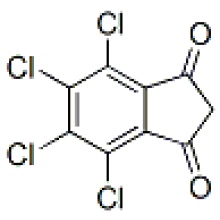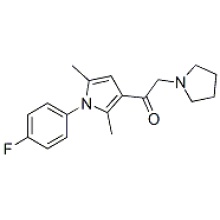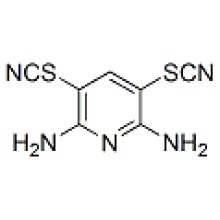.cp_wz tabla {borde superior: 1px sólido #ccc; borde izquierdo: 1px sólido #ccc; } .cp_wz table td {borde derecho: 1px sólido #ccc; borde inferior: 1px sólido #ccc; padding: 5px 0px 0px 5px;} .cp_wz table th {border-right: 1px solid #ccc; border-bottom: 1px solid #ccc; padding: 5px 0px 0px 5px;} \ n Peso molecular: 397.64 LDN-57444 es un inhibidor de proteasoma competitivo y reversible para Uch-L1 con IC50 de 0.88 μM, selectividad 28 veces mayor que la isoforma Uch-L3. \ n Tratamiento con 50 μM LDN-57444 durante 24 h conduce a una inhibición del 70% de la actividad del proteasoma. LDN-57444 provoca una disminución significativa y dependiente de la concentración en la viabilidad celular a concentraciones superiores a 25 µM y la viabilidad celular se reduce al 61,81% a 50 µM. LDN-57444 es capaz de causar la muerte celular a través de la vía de la apoptosis al disminuir la actividad del sistema proteasoma de ubiquitina y aumentar los niveles de proteínas altamente ubiquitinadas, las cuales pueden activar la respuesta de la proteína desplegada. La apoptosis inducida por LDN-57444 puede desencadenarse por la activación del estrés del retículo endoplásmico (ERS). LDN-57444 causa alteraciones dramáticas en la distribución de proteínas sinápticas y la morfología de la columna in vivo. El tratamiento con LDN también da como resultado una caída rápida de la actividad de Uch-L1, pero la inhibición del proteasoma no tiene ningún efecto sobre los niveles de cAMP durante un período de varias horas.
orte
|
HTS screen
|
To start an assay, 0.5 μL of 5 mg/mL test compound (about 50 μM final reaction concentration) or DMSO control is aliquoted into each well. Both enzyme and substrate are prepared in UCH reaction buffer (50 mM Tris-HCl [pH 7.6], 0.5 mM EDTA, 5 mM DTT, and 0.5 mg/mL ovalbumin). 25 μL of 0.6 nM UCH-L1 is then added to each well except substrate control wells, followed by plate shaking for 45–60 s on an automatic shaker. The enzyme/compound mixture is incubated at room temperature for 30 min before 25 μL of 200 nM Ub-AMC is added to initiate the enzyme reaction. The reaction mixture (300 pM UCH-L1, 100 nM Ubiquitin-AMC with 2.5 μg test compound) is incubated at room temperature for 30 additional minutes prior to quenching the reaction by the addition of 10 μL 500 mM acetic acid per well. The fluorescence emission intensity is measured on a LJL Analyst using a coumarin filter set (ex = 365 nm, em = 450 nm) and is subtracted by the intrinsic compound fluorescence to reveal the enzyme activity. A DMSO control (0.5 μL of DMSO, 25 μL of UCH-L1, 25 μL of ubiquitin-AMC, 10 μL of acetic acid), enzyme control (25 μL of UCH-L1, 25 μL of buffer, 10 μL of acetic acid), substrate control (25 μL of buffer, 25 μL of ubiquitin-AMC, 10 μL of acetic acid), and inhibitor control (0.5 μL of ubiquitin aldehyde [100 nM stock], 25 μL of UCH-L1, 25 μL of ubiquitin-AMC, 10 μL of acetic acid) are also performed in each assay plate to ensure quality and reproducibility. Potential UCH-L1 inhibitors are selected if the compounds demonstrated greater than 60% inhibition compared to the controls. The UCH-L1 enzymatic reactions are manually repeated twice using the same protocol to confirm the results for the hit compounds from the primary robot-assisted screen.
|
Ensayo celular: [1]
|
Cell lines
|
H1299
|
|
Concentrations
|
~5 μM
|
|
Incubation Time
|
24 h
|
|
Method
|
MTT assay
|
Estudio con animales: [2]
|
Animal Models
|
wild type and a-syn transgenic mice
|
|
Formulation
|
|
|
Dosages
|
0.5 mg/kg
|
|
Administration
|
intraperitoneally
|
Conversión de diferentes modelos de animales basados en BSA (valor basado en datos del Borrador de Directrices de la FDA)
|
Species
|
Baboon
|
Dog
|
Monkey
|
Rabbit
|
Guinea pig
|
Rat
|
Hamster
|
Mouse
|
|
Weight (kg)
|
12
|
10
|
3
|
1.8
|
0.4
|
0.15
|
0.08
|
0.02
|
|
Body Surface Area (m2)
|
0.6
|
0.5
|
0.24
|
0.15
|
0.05
|
0.025
|
0.02
|
0.007
|
|
Km factor
|
20
|
20
|
12
|
12
|
8
|
6
|
5
|
3
|
|
Animal A (mg/kg) = Animal B (mg/kg) multiplied by
|
Animal B Km
|
|
Animal A Km
|
Por ejemplo, para modificar la dosis de resveratrol utilizada para un ratón (22,4 mg / kg) a una dosis basada en el BSA para una rata, multiplique 22,4 mg / kg por el factor Km para un ratón y luego divida por el factor Km para una rata. Este cálculo da como resultado una dosis equivalente para ratas de resveratrol de 11,2 mg / kg.
|
Rat dose (mg/kg) = mouse dose (22.4 mg/kg) ×
|
mouse Km(3)
|
= 11.2 mg/kg
|
|
rat Km(6)
|
Información química
|
Molecular Weight (MW)
|
397.64
|
|
Formula
|
C17H11Cl3N2O3
|
|
CAS No.
|
668467-91-2
|
|
Storage
|
3 years -20℃Powder
|
|
6 months-80℃in solvent (DMSO, water, etc.)
|
|
Synonyms
|
|
|
Solubility (25°C) *
|
In vitro
|
DMSO
|
11 mg/mL
(27.66 mM)
|
|
Water
|
<1 mg/mL
(
|
|
Ethanol
|
<1 mg/mL
(
|
|
|
Chemical Name
|
1H-Indole-2,3-dione, 5-chloro-1-[(2,5-dichlorophenyl)methyl]-, 3-(O-acetyloxime)
|
|
Stock Solution (1ml DMSO)
|
1mM
|
10mM
|
20mM
|
30mM
|
|
Mass(mg)
|
0.39764
|
3.9764
|
7.9528
|
-
|
Grupos de Producto : Ubiquitina > Inhibidor DUB








